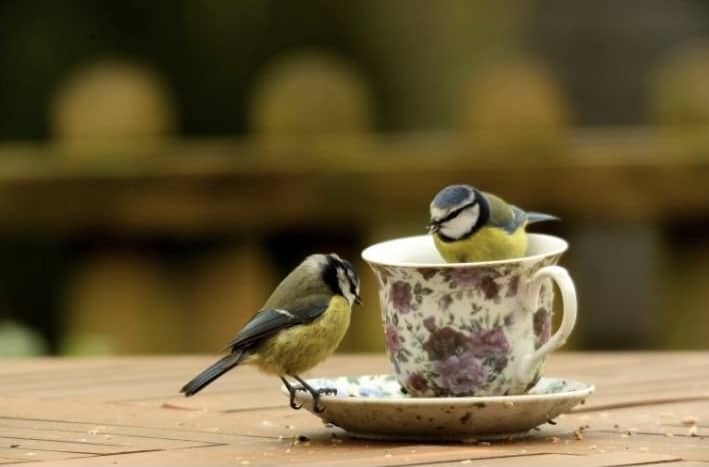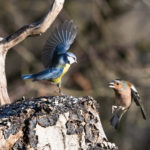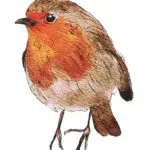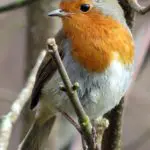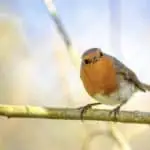Most people watch birds without even thinking about it. It is human instinct for a bird to catch our eyes, and our curiosity takes over, gathering information about what it is doing and how it interacts with the environment or other birds. Many people find satisfaction in birdwatching. Our brains are stimulated by trying to remember the names and habitats of each bird species; or by observing and recognising the little details of each bird.
Blue Tits
One of the most common birds to observe in the United Kingdom is the Blue Tit. This little energetic bird can be found in gardens, parks, and woodland areas. Anywhere there are trees and bushes for them to find food and breed in, you will find the Blue Tit. Blue Tits are particularly fun to watch as they perform all kinds of air aerobics to catch their prey, they are high energy, and their plumage are bright and colourful.
Blue Tits got their name from the blue colour of their plumage. Their heads are white with a bright blue cap on top of their heads and a black stripe across their eyes. Another black stripe starts at their bills and goes vertically down their necks. Another black stripe starts about mid-chest and travels down to their legs. This stripe is much thinner and more subtle. The rest of their chest and belly is bright yellowish-green. Their wings and tails are blue with a tinge of green on their backs. They have black bills with a highlight of white and bluish-grey legs.
How to Tell the Difference Between a Male & Female Blue Tit
Both male and female Blue Tits display the same brightly coloured plumage. It is not easy to tell the male and female Blue Tit apart by their appearance alone. Female Blue Tits may have a slightly muted colour palette than the males. Males may sport a more vibrant blue cap. However, it will take patience and practice to identify the subtle differences without a trained eye.
The most apparent difference between male and female Blue Tits is the black neckband marking that runs below the eyes and continues behind the neck. In males, this stripe is often broader and more prominent than in females.
Observing the behaviour and patterns of the Blue Tit will be a much more telling indicator of the gender of a Blue Tit.
Breeding Behaviours of the Blue Tit
Blue Tits spend most of their time looking for food. They are often seen picking up seeds and nuts from bird feeders, grabbing a seed before flying off to their favourite perch to consume their prize. They will also dart around the garden or part, hunting insects and spiders. Their favourite meal consists of caterpillars.
Usually, in April, the Blue Tits start changing their behaviours to prepare for the breeding season. Although both the male and female Blue Tits maintain their active pace, their time is spent differently. This will be the best time to differentiate between the male and female Blue Tits. Once you determine which behaviours they are displaying, you will identify their gender.
Female Blue Tits will begin building their nests. The female Blue Tits are solely responsible for this endeavour. During this time, you will observe the female Blue Tits carrying resources, such as moss, twigs, and spider webs. Blue Tits will utilise man-made nesting boxes, build their nests in tree hollows, or even on in gutters or mailboxes. Their nests are cup-shaped are lined with soft materials, such as fur, hair, wool, and feathers. It usually takes a female Blue Tit one to two weeks to complete her nest.
While the female Blue Tit builds her nest, the male Blue Tit becomes very territorial and spends his time defending his territory from other males. Males will also become much more vocal during this season to attract as many females as possible to their territory. His mating call and dance consist of him fluffing out his feathers and moving backwards and forward with his head tilted back. He may also try to lure females by bringing them food treats. Male Blue Tits are polygamous and often have several mates during the breeding season.
The Incubation Period
In May, the female Blue Tit will begin laying her eggs. During this time, you will be less likely to see a female Blue Tit. Since the male Blue Tits are responsible for feeding their mates and their chicks, you will most likely notice the males dashing about seeking food.
Female Blue Tits lay one egg a day and will usually lay between eight and twelve eggs. Some clutches may have as many as sixteen eggs. Since this takes so much of her energy, she has little energy left for doing anything else. The female Blue Tit will also pluck some of the feathers from her chest. This is known as her brood patch. By removing her feathers, she will allow the eggs to contact her skin, keeping them warm until they hatch.
The male Blue Tits will make several trips to feed his mates during this incubation period. After the eggs hatch, the male Blue Tit will continue to feed his mate and their chicks. At this time, the females will begin leaving the nests again and assist in feeding the chicks. Insects, especially caterpillars, are vital food sources which are rich in nutrients for the hatchlings.
Final Thoughts
Identifying the differences between male and female Blue Tits is not an easy feat. Spend time observing the behaviours of the birds in your garden and learn to understand their habits and patterns. During the breeding season, observe the mission of each of the individual Blue Tits to identify their gender. Once you have determined which birds are male and female, compare their neckbands. Learn to distinguish between a thicker and thinner stripe. This will be slightly easier if you can spot a male and female Blue Tit together. Most importantly, enjoy sitting back and watching the cycle of life and the beauty of the natural world on display before you. Happy Birdwatching!
